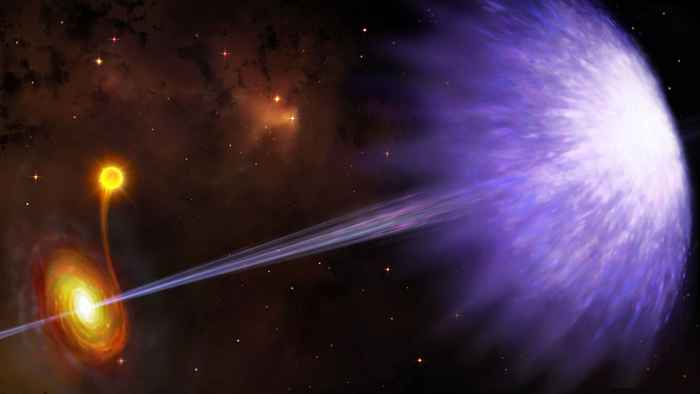Invisible jets from tiny black holes sculpt the Galaxy
25 April 2025

New research reveals that the influence of black holes extends far beyond their immediate surroundings, challenging our understanding of these enigmatic objects. While black holes are infamous for compressing matter into an infinitely dense point and warping the very fabric of space and time, their effects may reach farther than previously imagined. Astronomers have uncovered new evidence of how small black holes could shape galaxies, revealing powerful shockwaves driven by high-energy, dark jets. These jets can travel through space for tens of light years after being launched.
Massive bow shock structures
Using the MeerKAT radio telescope, the research team has mapped massive bow shock structures caused by the jets from the black holes GRS 1915+105 and Cygnus X-1, providing new insights into the long-term effects of the activity of these systems on their surrounding space. “These discoveries show that stellar black holes can actively sculpt their surroundings, leaving behind enormous shockwaves that tell a story spanning thousands of years,” said Dr. Sara Elisa Motta, astronomer at the Instituto Nazionale di Astrofisica (INAF), Italy.
Cygnus X-1, the first stellar-mass black hole ever discovered, has been known to launch powerful jets of high-energy particles that form a massive bow shock structure. This structure is blown by the black hole jets at a distance that is almost three times as big as the black hole-star system. Now, for the first time, MeerKAT has detected such formations in two different radio frequencies, allowing scientists to map them in unprecedented detail. This has revealed previously unseen details in the shock, hinting at multiple jet activity periods that occurred over the past thousands of years, during which the jets interacted with their surroundings at different locations in space. “This is a smoking gun for how black holes influence the space around them,” said Dr. Pikky Atri, astronomer at the Netherlands Institute for Radio Astronomy (ASTRON) and Radboud University. “It’s like a cosmic archaeological dig – each layer of the shock tells a story of past jet eruptions.”
Dr Jakob van den Eijnden, researcher at the Anton Pannekoek Institute for Astronomy at the University of Amsterdam, adds: “This discovery also highlight how state-of-the-art telescope, like MeerKAT, allow us to detect these enormous structures despite their faintness. That makes me optimistic that we will find similar black hole footprints around a much larger number of black holes with the next generation of radio telescopes, which are currently being constructed.”
Never-before-seen
Meanwhile, in a breakthrough discovery, astronomers have detected a never-before-seen jet-driven bow shock near GRS 1915+105. The structure, spanning 30 light-years, is evidence of a powerful but unseen jet carving a massive cavity in space. This discovery confirms that the jets from this system are able to significantly impact the black hole’s environment, bridging the gap between theories in the early 2000’s suggesting this bow shock should exist, to finally now detecting it almost two decades later.“We always thought a bow shock around GRS 1915+105 should exist, having seen something similar around Cyg X-1. However, we could not detect it, which led to a lot of confusion. Until MeerKAT discovered the bow shock near GRS 1915+105, scientists started to wonder whether bow shocks could be formed only around some black hole systems,” explained Dr. Sara Elisa Motta.
These findings help explain how even smaller black holes play a major role in shaping galaxies. While supermassive black holes at the centers of galaxies are known to drive large-scale changes, these findings prove that even much smaller, stellar-mass black holes can dramatically reshape their surroundings. Despite being millions of times less massive than their supermassive counterparts, these black holes still leave behind vast, detectable structures—an impact that was previously underestimated.
MeerKAT’s groundbreaking observations suggest that similar shockwaves—remnants of ancient black hole activity—may be hidden throughout our galaxy, waiting to be discovered. Scientists are now actively searching for more of these elusive structures, aiming to map the Milky Way’s hidden black hole history.
About MeerKAT
MeerKAT is a world-class radio telescope located in South Africa. As a precursor to the Square Kilometre Array (SKA)—the largest radio telescope ever to be constructed—MeerKAT plays a vital role in uncovering the universe’s hidden structures and phenomena.
With its exceptional sensitivity, MeerKAT is unveiling faint, jet-driven features that mark a new chapter in black hole physics. These discoveries are helping researchers trace the long-term impact of black holes across both time and space.
About the Research Teams
This research is led by astronomers from ASTRON and INAF, in collaboration with an international team from the Anton Pannekoek Institute for Astronomy, University of Oxford, Curtin University, University of Manchester, Rhodes University, and the University of Cape Town.
Publication details
“MeerKAT discovers a jet-driven bow shock near GRS 1915+105”, Astronomy & Astrophysics Volume: 696 / 2025 / A222. DOI: 10.1051/0004-6361/202452838. URL: https://www.aanda.org/10.1051/0004-6361/202452838
“Quantifying jet--interstellar medium interactions in Cyg X-1: Insights from dual-frequency bow shock detection with MeerKAT”, Astronomy & Astrophysics Volume: 696 / 2025 / A223. DOI: 10.1051/0004-6361/202452837 URL: https://www.aanda.org/10.1051/0004-6361/202452837